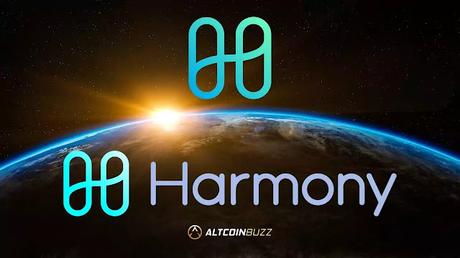
pic credit: altcoinbuzz
What is Harmony?
While you may believe you've heard everything there is to know about prospective layer 1 blockchain solutions, what if I told you there is currently a product on the market that functions similarly to ETH 2.0?
What if I told you that this layer 1 was as quick as Visa in terms of transactions per second, but also in terms of transaction completion? Harmony is a smart-contract platform that is attempting to solve the blockchain trilemma.
This trilemma states that a blockchain cannot sustain security, decentralization, or scalability without compromising on one of those three key characteristics. Harmony, on the other hand, would disagree.
Stephen Tse launched Harmony, popularly known for its ticker ONE, in 2018. Tse has the credentials to back up his concept, as do many strong crypto projects. He earned his Ph.D. in security protocols and compiler verification from the University of Pennsylvania and has been self-described as "obsessed" with protocols and compilers since high school, where he reverse-engineered the ICQ and X11 protocols.
Tse went on to work for Microsoft Research, Google as a senior infrastructure engineer, and Apple as a principal engineer for search ranking. Tse also launched the mobile search company Spotsetter. Apple eventually purchased this company. Overall, Tse looks to have everything of the interests, knowledge, and experience you could want to start a blockchain protocol.
Though, what about the project itself?
Harmony, like all layer 1 smart-contract platforms, promises to offer the infrastructure that permits and encourages other developers to build projects on their network, with Harmony's ONE token serving as a payment facilitator for subscriptions, fees, gas, and other services on this new blockchain.
You might wonder why someone would choose Harmony over, say, Ethereum, and the answer is simple: fees and transaction times. Harmony, like Ethereum, is based on the Proof of Stake consensus method, albeit it uses a modified version known as Effective Proof of Stake or EPOS for short. In terms of functionality, EPOS is comparable to how Ethereum 2.0 is projected to operate once it is launched.
This is due to EPOS's use of sharding technology, which allows the chain to scale more effectively than raw PoS. Harmony has chosen four side-chains instead of the planned 64 in ETH 2.0. There are advantages and disadvantages to having more or fewer shards, and it all boils down to security. A shard attack becomes easier to accomplish as the number of shards increases.
To simplify a complex topic, you can begin to attack the network if you successfully corrupt a single shard. For example, if you had 100 shards that each hold 1% of the network, you only need to trick 1% of the network to begin attacking the whole platform.
In traditional PoS, it would require 51% of the network to begin attacking, so you can see the pros and cons of many shards. More shards equal better scalability but do create new vulnerabilities too. Both Harmony and ETH 2.0 aim to combat the potential of a shard attack by randomly assigning nodes to specific shards and constantly reassigning them at random intervals. Thus, making it more difficult for an attacker to know where and when to attack to successfully take over a single shard.
Universal Basic Income, or UBI.
You might be thinking that Harmony is just an early version of ETH 2.0. It does, however, have one distinguishing element that sets it apart from its competitors: Universal Basic Income, or UBI. While we've seen fast cryptocurrencies before, Harmony's UBI program aims to give back to the community.
This is effectively communal money that is returned to the participants. Advertisements are used to raise money for this fund. When an advertiser pays a price to appear on the Harmony blockchain, a portion of that amount is returned to those who are staking, maintaining the network's security.
When you consider Harmony's plans for a UBI-style program, as well as the fact that their four shards can produce a combined output of 2000 transactions per second, achieving finality in less than 2 seconds, it's easy to see why people are talking about this project. Harmony would surpass Solana and even Visa with those 2000 transactions per second and a 2-second transaction finality, making it one of the quickest payment systems on the globe.
To round off the good news, Harmony recently actively increased its collaborations in order to raise brand recognition. SushiSwap, Binance, and Terra are among the largest of these collaborations.
So what has all this done for the price of Harmony's ONE token?
Harmony's ONE token launched on exchanges in June 2019 for $0.02 and quickly fell to an all-time low of $0.01 by March 2020. ONE would then enter a rabbit market, never quite breaching into the $0.03 range.
Harmony's fortunes altered in February 2021, when the crypto market as a whole rallied. By March, ONE was trading at $0.20, but as Harmony investors were about to find, fortune swings in crypto may come and go as quickly as they seem.
Prices continued to drop until July when they reached as low as $0.05. Fortunately, the best was yet to come for ONE holders. From July, ONE saw another explosion in value, this time taking it to as high as $0.37 by October, which remains its all-time high. ONE currently trades at around $0.33.
What is the future looking like for this exciting altcoin?
Despite offering a 5000% return in the previous year alone, things aren't currently looking great for the short term. Currently trading on the negative side of its MA Cross and MACD, there could be more red days ahead. The only saving grace is ONE is currently trading within its RMA.
Although, this is likely due to the recent spike, meaning Harmony's ONE token is on shaky legs. Though the start of 2022 sees Harmony rise to regain $0.33, we feel once the bear market appears, ONE could slip to as low as $0.05, where it has found previous support. Moving into 2023, we do not expect ONE to defy the market should a bear market take hold.
Alternatively, we don't see the price dropping much further, as we assume most short-term holders will likely have exited their positions during 2022. Good news should begin to reappear in 2024, as with the Bitcoin halving crypto-mania should slowly start to reappear.
Typically, promising projects are bought up early in anticipation of the price spike, and we feel ONE could be near the top of many investors' shortlists. We feel $0.60 is achievable during this time, as this still wouldn't make Harmony a top 40 project by today's market caps.
Meaning, this figure should be easily possible should they navigate any turbulence successfully between now and then. Lastly, in 2025, should Harmony continue to have good fortune, we can see Harmony's ONE token finally exceeding $1, perhaps going as high as $1.20 before the market begins to enter its next bull cycle.
To achieve this aim, Harmony would only need to reach the current market cap of Uniswap and seeing as this is barely a top 20 cryptocurrency, we don't feel this target is unrealistic, providing no misfortunes bestow the company moving forward. Harmony currently provides most of the features Ethereum fans have been waiting for, all while maintaining a $3 billion market cap.
Meaning, the upside potential for this project could be immense should they manage to flesh out their project into a complete ecosystem while avoiding any significant mishaps in management. But now we ask you, what is your favorite layer 1 protocol? Do you believe in the superiority of Ethereum, or will one of these challengers dethrone the smart-contract king?

